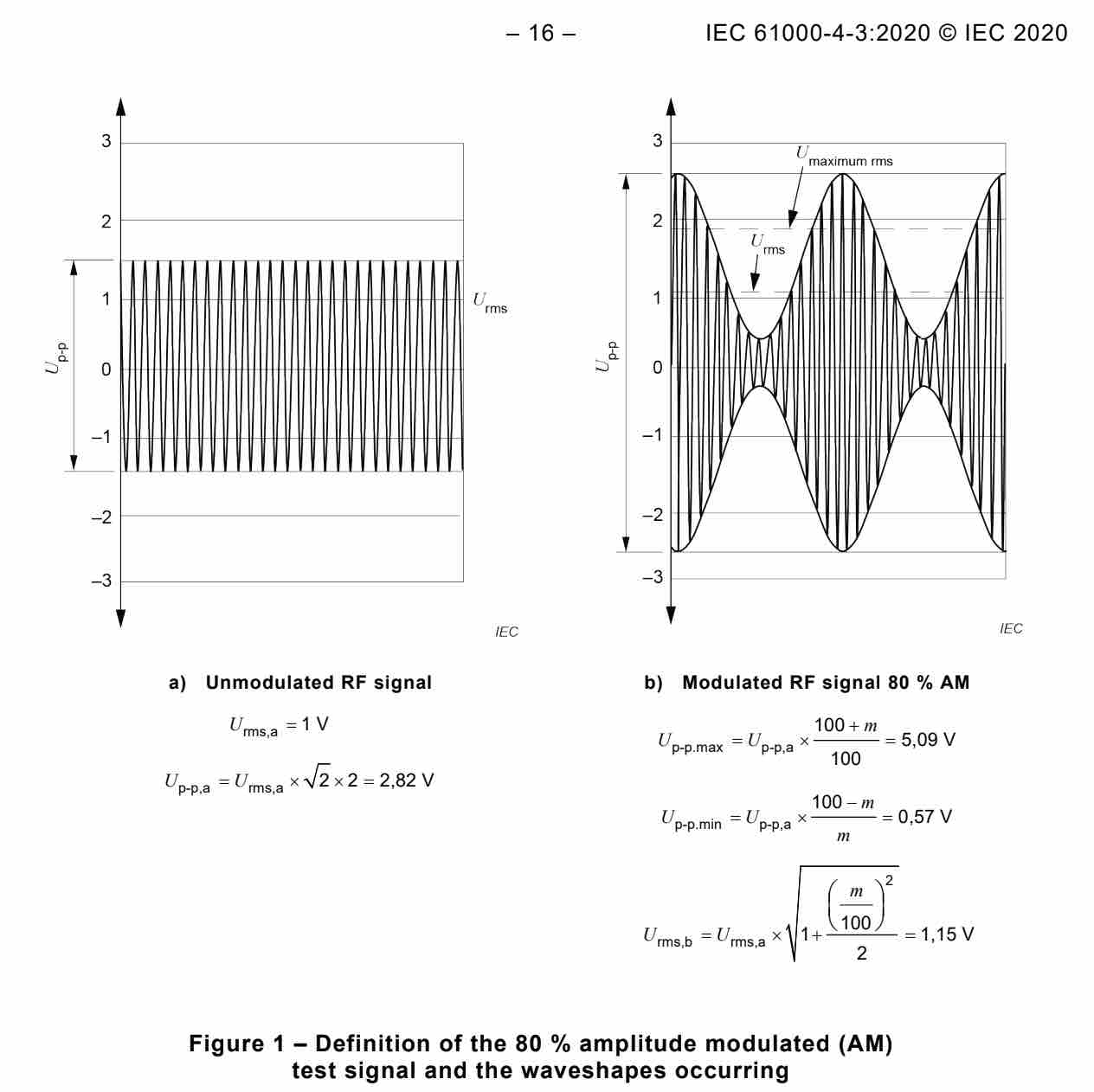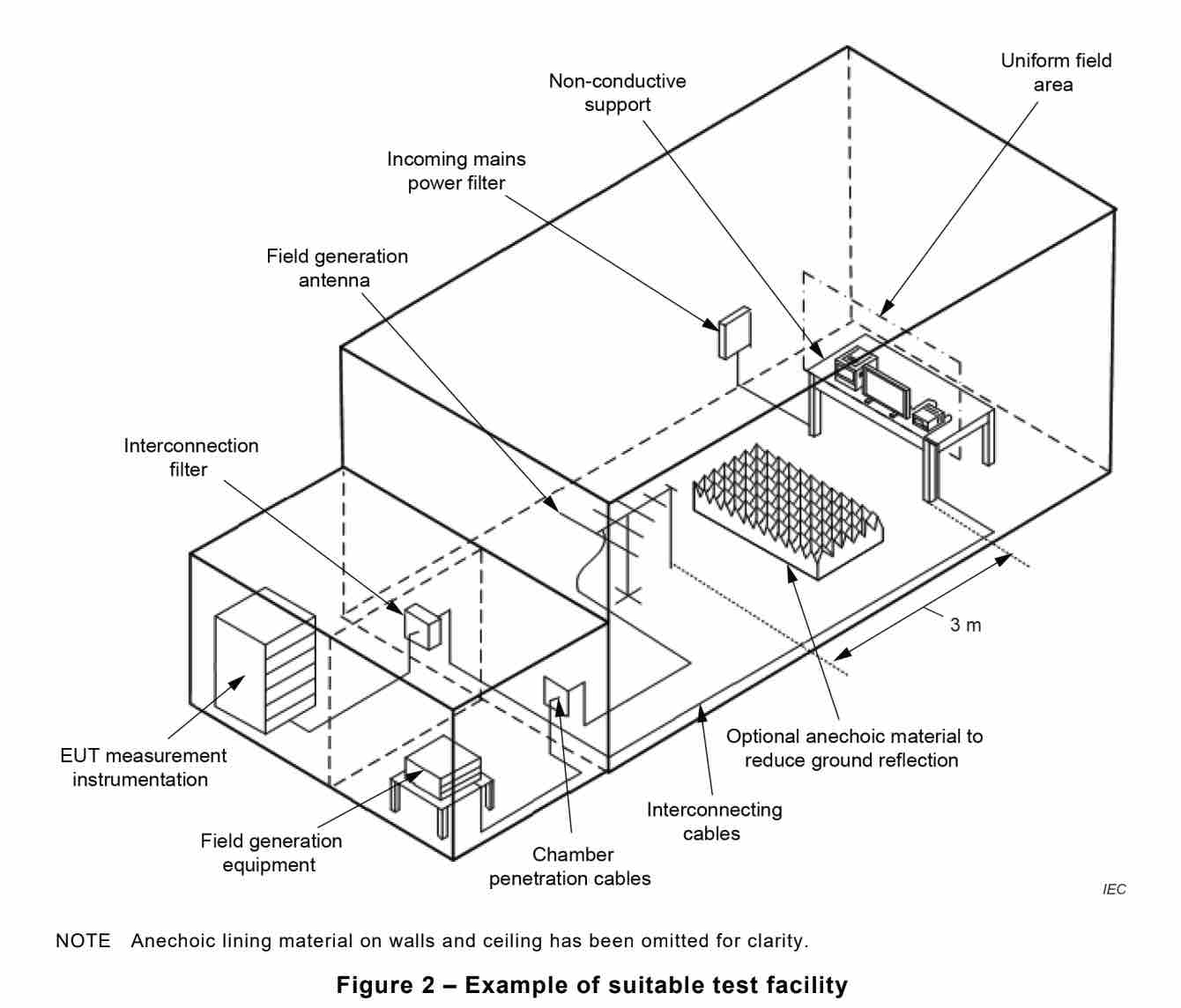What is IEC 61000-4-3?
IEC 61000-4-3 is one of the EMC standards. It specifies immunity requirements of electrical and electronic equipment to radiated electromagnetic energy. It establishes test levels and the required test procedures. The object of the standard is to establish a common reference for evaluating the immunity of electrical and electronic equipment when subjected to radiated, radio-frequency electromagnetic fields. The test method describes a consistent method to assess the immunity of an equipment or system against RF electromagnetic fields from RF sources not in close proximity to the EUT. Full title of the standard is
Electromagnetic compatibility (EMC) –
Part 4-3: Testing and measurement techniques – Radiated, radio-frequency electromagnetic field immunity test
How to download IEC 61000-4-3?
IEC standards are not free of charge. Thus, IEC sells its standards via their web stores. Visit IEC webpage and buy online and download. Ensure that you are downloading the recent version of the standard. Current version is IEC 61000-4-3:2020. Before buying you can see its preview version for free.
For which products IEC 61000-4-3 is applied?
Almost all electrical and electronic equipments are under the scope of this standard. Since this standard is a basic EMC publication, applying it without a product standard is not possible. The standard added this note about this issue:
”As described in IEC Guide 107, this is a basic EMC publication for use by product committees of the IEC.
As also stated in Guide 107, the IEC product committees are responsible for determining whether this immunity test
standard should be applied or not, and if applied, they are responsible for determining the appropriate test levels
and performance criteria. TC 77 and its sub-committees are prepared to co-operate with product committees in the
evaluation of the value of particular immunity tests for their products.”
Which product standards refer to IEC 61000-4-3?
Most of the EMC product standards refers to IEC 61000-4-3 standard for Immunity to Radiated RF Fields tests. Some of these standards are CISPR 35, EN 55035, IEC 61547, EN 61547, IEC 60601-1-2, EN 60601-1-2, IEC 61000-6-1, EN 61000-6-1, IEC 61000-6-2 and EN 61000-6-2. Almost all commercial products are subjected to radiated immunity tests according to IEC 61000-4-3 together with its upper level product standard. Test levels and performance criteria are given on product standards.
Which tests are applied according to IEC 61000-4-3?
IEC 61000-4-3 is shortly a radiated immunity test standard. Test names are mentioned on product standards. The most used names are as follows:
Radiated Immunity
Immunity to Radiated RF fields
RF Field Radiated Immunity tests
All of these above test names indicate same test: applying a field to the EUT and montitoring its performance.
Test Levels
Five test levels are given on IEC 61000-4-3:2020:
| Level | Test field strength (V/m) |
| 1 | 1 |
| 2 | 3 |
| 3 | 10 |
| 4 | 30 |
| x | Special |
x can be any level, above, below or in between the others. The level shall be specified in the product standard.
The standard does not suggest that a single test level is applicable over the entire frequency range. The product committees shall select the frequency range(s) to be tested as well as the appropriate test level(s).
As seen on above table, there are more than one test levels. Product standard defines the level to be applied. Test Level 1 and 2 are much more popular than the others since these two test levels are given on product standards of commercial products.
The test field strength column in above table gives values of the unmodulated carrier signal. For testing of equipment, this carrier signal is amplitude modulated with a 1 kHz sine wave to simulate actual threats. Figure 1 of the IEC 61000-4-3:2020 shows the definition of AM test signal:

Frequency Ranges
IEC 61000-4-3:2020 defines testing in the frequency range above 80 MHz, limited only by the capability of the test instrumentation. The frequencies or frequency ranges to be selected for testing by product committees may be limited to those where intentional RF emitting devices actually operate.
Product committees can require a specific test level and type of modulation (as alternative to 80 % AM).
If the product is intended to conform only to the requirements of particular countries, testing may be reduced to cover just the specific frequency bands allocated to digital mobile telephones and other intentional RF emitting devices in those countries.
Start frequency is given as 80 MHz, stop frequency can be 1, 6, 18 GHz or a higher frequency. The upper frequency of this test is given on product standards.
Which test instruments are used during IEC 61000-4-3 tests?
1. Anechoic Chamber
Anechoic chamber of a size adequate to maintain a uniform field of sufficient dimensions with respect to the equipment under test (EUT). Additional absorbers may be needed to damp reflections.
2. EMI Filters
for making connections between inside and outside the anechoic chamber
3. RF Signal Generator
RF signal generator(s) shall be capable of covering the frequency band of interest and as a minimum being capable of amplitude modulation. The use of low-pass or band-pass filters can be necessary to avoid problems caused by harmonics.
4. Power Amplifier
It is required to amplify the signal (unmodulated and modulated) and provide antenna drive to the necessary field level.
5. Field Generating Antennas
Biconical, log periodic, horn, combination of antennas or any other linearly polarized antenna system capable of satisfying frequency requirements.
6. Isotropic Field Sensor
An isotropic field sensor with adequate frequency range and sensitivity to measure the generated field strength. Annex K of the standard is for calibration method for E-field probes.
7. Power Measurement Device
Power measurement device for the forward power:
* a directional coupler and a power meter
or
* a forward power detector or monitor could be inserted between amplifier and antenna.
8. Associated equipment to record the power levels
It is necessary for the required field strength and to control the generation of that level for testing. Test software would be helpful.
Test Facility Requirements according to IEC 61000-4-3
Radiated Immunity tests shall be made in a shielded enclosure in order to comply with various national and international laws prohibiting interference with radio communications. Because magnitude of the field strengths generated is high.
In addition, since most test equipment used to collect data is sensitive to the electromagnetic field generated during the execution of the immunity test, the shielded enclosure provides the necessary “barrier” between the EUT and the required test instrumentation. Care shall be taken to ensure that the interconnection wiring penetrating the shielded enclosure is adequately isolated from the conducted and radiated emission and preserves the integrity of the EUT signal and power responses.
The test facility typically consists of an Absorber Lined Shielded Enclosure (ALSE) large enough to accommodate the EUT whilst allowing adequate control over the field strengths. This includes anechoic chambers or modified semi-anechoic chambers, an example of which is shown in below figure. Associated shielded enclosures should accommodate the field generating and monitoring equipment, and the equipment which exercises the EUT.
IEC 61000-4-3:2020 refers to its Annex C for further guidance on the use of anechoic chambers.

Uniform Field Area (UFA)
The standard uses the concept of a uniform field area (UFA), which is a vertical plane of the field in which variations are within limits specified below. The methods given in the standard are used to demonstrate the capability of the test facility and the test equipment to generate the uniform field for testing. Data for setting the required field strength for the immunity test is obtained and is used to test all EUTs.
UFA or Field Uniformity is the most essential parameter of the anechoic chamber to be used while performing radiated immunity tests according to IEC 61000-4-3. Thus, anechoic chamber’s performance shall be verified by field uniformity measurements. These performance validation measurements either can be performed by chamber manufacturer, test expert (owner of the chamber) or a third party validation service provider. Certifying the anechoic chamber is essential to show a proof of compliance of the chamber.
The uniform field level setting is performed with no EUT in place. In this procedure, the relationship between field strength within the UFA and forward power applied to the antenna is determined. During the test, the required forward power is calculated from this relationship and the target field strength. The actual test field strength can be different from
the level setting field strength provided that the linearity of the system can be demonstrated. The level setting is valid as long as the setup of the test instrumentation used remains unchanged for testing. Since even small displacements can significantly affect the field, it is important, especially at high frequencies, that the position of test instrumentation such as antennas, absorbers, cables, etc., is recorded.
What we offer about IEC 61000-4-3?
We offer:
1) Testing services according to IEC 61000-4-3 for your electronic products. Have testing service via Testups. We are partnering with accredited EMC testing labs which are able to perform IEC 61000-4-3 tests for your product.
2) Test instruments or systems according to IEC 61000-4-3. If you would like to perform radiated RF field immunity tests according to IEC 61000-4-3, we are offering turnkey solutions including delivering of calibrated test systems to your address. In addition to delivery of IEC 61000-4-3 test systems, you can also order online or onsite training or installation services.
3) Anechoic chambers compliant with IEC 61000-4-3. If you would like to perform radiated RF field immunity tests according to IEC 61000-4-3, we are offering turnkey anechoic chamber solutions including supplying anechoic chamber materials, on-site installation and validation services. In additon to installation IEC 61000-4-3 anechoic test chambers, you can also order online or onsite training or installation services.
Do you need testing services, test equipments or anechoic chambers related to IEC 61000-4-3?
Send us your EMC requirements and get your quote.